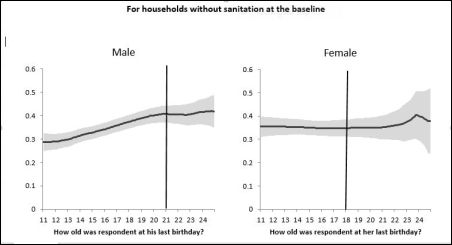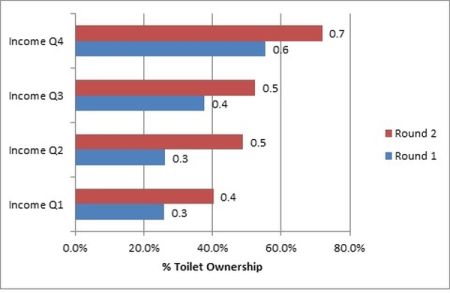A growing body of research shows that costs are a key barrier to sanitation investments by households. Based on a survey in Madhya Pradesh and Tamil Nadu, this column finds that apart from financial and health considerations, the decision of households to acquire toilets is influenced by the belief that toilet ownership improves prospects of finding good marriage matches for sons.
Ensuring access and availability of clean water and sanitation for all has been marked as the 6th Goal in the new United Nations (UN) Sustainable Development agenda. Within this goal, bringing an end to open defecation is a significant target, not only for its expected wide-ranging implications on community health, but because of its potential knock-on effects on education and welfare of women and girls in vulnerable situations.
In India, open defecation remains one of the biggest sanitation challenges today. While ‘moderate’ progress has been made, figures show that over the last 20 years, there has been very little reduction in open defecation amongst the poor. Assuming that the characteristic profile of the households that currently build toilets remains unchanged, back-of-the-envelope calculations suggest that the Government of India, would “have to construct 81 toilets per minute – day and night – starting 1 January 2015 to meet its goal of eliminating open defecation by the end of 2019, or 41 toilets per minute to meet the United Nation’s goal of eliminating open defecation by 2025”.
Given the enormity of this task, we ask first what drives the uptake of sanitation; and second, how policies be designed to accelerate this process? (Augsburg and Rodríguez-Lesmes 2015)
In a recent Ideas for India column, Guiteras, Levinsohn and Mobarak discussed the results of a field experiment in Bangladesh that examines a range of sanitation marketing strategies. They find that amongst others, costs are the primary barrier to investments in toilets.
In this column, we complement and expand on earlier findings with summary results from an ongoing study of the determinants of toilet uptake and acquisition in India. The study is based on the urban slum population of the city of Gwalior, in the state of Madhya Pradesh in central India, peripheral villages around the same city, and a rural village population from the Thiruvarur district in the southern state of Tamil Nadu. Using data collected at two separate intervals (2009 and 2014), household characteristics are used to understand which factors predict uptake and investment decisions for private latrines, over time.
Financial constraints matter
The determinants of toilet ownership and acquisition that our findings reveal are for the most part, in line with expectations. We find for example that richer households, households with higher education, and households from higher castes are more likely to own a toilet. Similarly, households with savings and greater credit access are also more likely to make sanitation investments. Interestingly however, a further finding reflects a shift towards greater inclusion over time along these margins.
Figure 1, for example, displays the percentage of households owning a toilet in the two survey rounds by income quartile. While in the first round of data collection (light grey bars) we observe a very clear increase in ownership with increase in income, the second round, shows a shift happening over time with poorer households increasing their relative likelihood of owning a toilet (dark grey bars).
Figure 1: Toilet ownership and income
Increased access by households with lesser means is likely to be, at least partly, driven by improved credit access. However, constraints in the study design do not allow us to establish a clear link. Our data suggests that – although most toilets are reportedly financed through savings - access to credit does play an important role in households’ investment decisions in sanitation.
Toilet acquisition believed to improve marriage prospects of boys
Although significant, financial constraints are not the only barrier to toilet ownership. Several studies support this finding including: the low uptake of vouchers in the above-mentioned study by Guiteras et al. (2015), the low achievements of government subsidies, and initial results from sanitation loan programmes (Augsburg and Rodriguez-Lesmes 2015b).
The traditional approach of raising awareness and demand creation through health messaging does not seem to be enough to motivate households and communities to fully eradicate the practice of open defecation. Our analysis suggests instead that messaging around status and social mobility might resonate better with poor populations in India.
Campaigns such as ‘no toilet, no bride’, launched by the Government of Haryana in 2005 are a worthwhile marketing strategy to explore. An analysis of this campaign finds that greater male investments in toilets may be the result of higher numbers of females with strong sanitation preferences. In line with this, our study provides evidence that anticipated marriage and the practice of brides moving into the house of their husband’s family are important motivating factors for the acquisition of toilets. We show that households with male children close in age to entering the marriage market are more likely to acquire toilets.
Figure 2 plots the rate of toilet adoption over time and conditional on other household characteristics that we previously showed to be important determinants of toilet adoption, such as savings, income and caste. We look just at households that have children in the age range 12-24 years. The left panel of Figure 2 shows adoption rates of households with boys in this age range and the right panel that of households with girls. While the adoption rate remains relatively constant for households with girls of marriageable age, we see a significant increase in households with boys of a marriageable age.
Our analysis reveals that households with boys of marriageable age are, on average, 10 percentage points more likely to invest in a toilet than households with girls of marriageable age – which can be interpreted as a clear signal that toilet investment are believed to improve outcomes in the marriage market.
Figure 2. Age of children and household sanitation adoption
 Notes: (i) Local averages with 90% confidence intervals for households with children 11 to 24 years old. (ii) 1,110 observations for males and 734 observations for females.
Notes: (i) Local averages with 90% confidence intervals for households with children 11 to 24 years old. (ii) 1,110 observations for males and 734 observations for females. Additional evidence points to importance of the marriage market as a driving factor in household sanitation adoption. Data shows that 80% of toilet owners across our different study settings report that their status in the community has increased since they constructed a toilet. And, more importantly, women reported that sanitation did indeed play an important role in their marriage decision – supporting our claim that toilet investment can improve the marriage prospects of boys.
Unlikely status symbol: Emphasising gains to social status may encourage toilet acquisition
Overall, our findings are consistent with a growing body of research that shows that liquidity constraints are binding and substantial for private latrines. Hence, any intervention that aims to increase household sanitation coverage must address financial barriers.
However, even when financial barriers are lifted, households face competing investment possibilities and need to weigh the benefits of one investment against another. Our evidence suggests that sanitation adoption decisions in the Indian context are not only driven by health considerations - the typical departure point for sanitation promotion programmes - but also by potential economic benefits. These include self-reported increases in social status, dwelling value, and as we discussed in detail in this column, the prospects of better marriage matches for their sons.
In societies where large financial investment decisions are typically made by men, advocating for the benefits of sanitation that appeal more to men may be a worthwhile strategy to pursue in order to reach the goal of eliminating open defecation.
Further Reading
- Alzua, ML, AJ Pickering, H Djebbari, C Lopez, JC Cardenas, MA Lopera, N Osbert, M Coulibaly (2015), ‘Final report: Impact evaluation of community-led total sanitation (CLTS) in rural Mali’.
- Augsburg, B and P Rodriguez-Lesmes (2015a), ‘Sanitation dynamics: toilet acquisition and its economic and social implications’, Institute for Fiscal Studies Working Paper Series, No. W15/15.
- Augsburg, B and P Rodriguez-Lesmes (2015b), ‘Financing household sanitation through microfinance - impacts and challenges’, Unpublished Working Paper.
- Augsburg, B, B Caeyers and F Oteiza (2015), ‘The costs and benefits of investing in a toilet – views from Indian and Nigerian households and their policy implications’, IFS Policy Brief, ISBN: 978-1-909463-94-3.
- Guiteras, R, J Levinsohn and M Mobarak (2015), ‘Encouraging household investment in sanitation’, Ideas for India, 13 May 2015.
- Joint Monitoring Programme for Water Supply and Sanitation (2015), ‘Progress on Sanitation and Drinking Water: 2015 Update and MDG Assessment’ WHO/UNICEF, Technical Report, Geneva, New York.
- Yaniv Stopnitzky (2012), ‘The Bargaining Power of Missing Women: Evidence from a Sanitation Campaign in India’, MPRA Paper 37841, University Library of Munich, Germany, February.
- Yaniv Stopnitzky (2014), ‘Throwing money down the toilet? India’s Toilet Subsidies and Sanitation Investment’, Working Paper, November.




 30 September, 2015
30 September, 2015 






Comments will be held for moderation. Your contact information will not be made public.